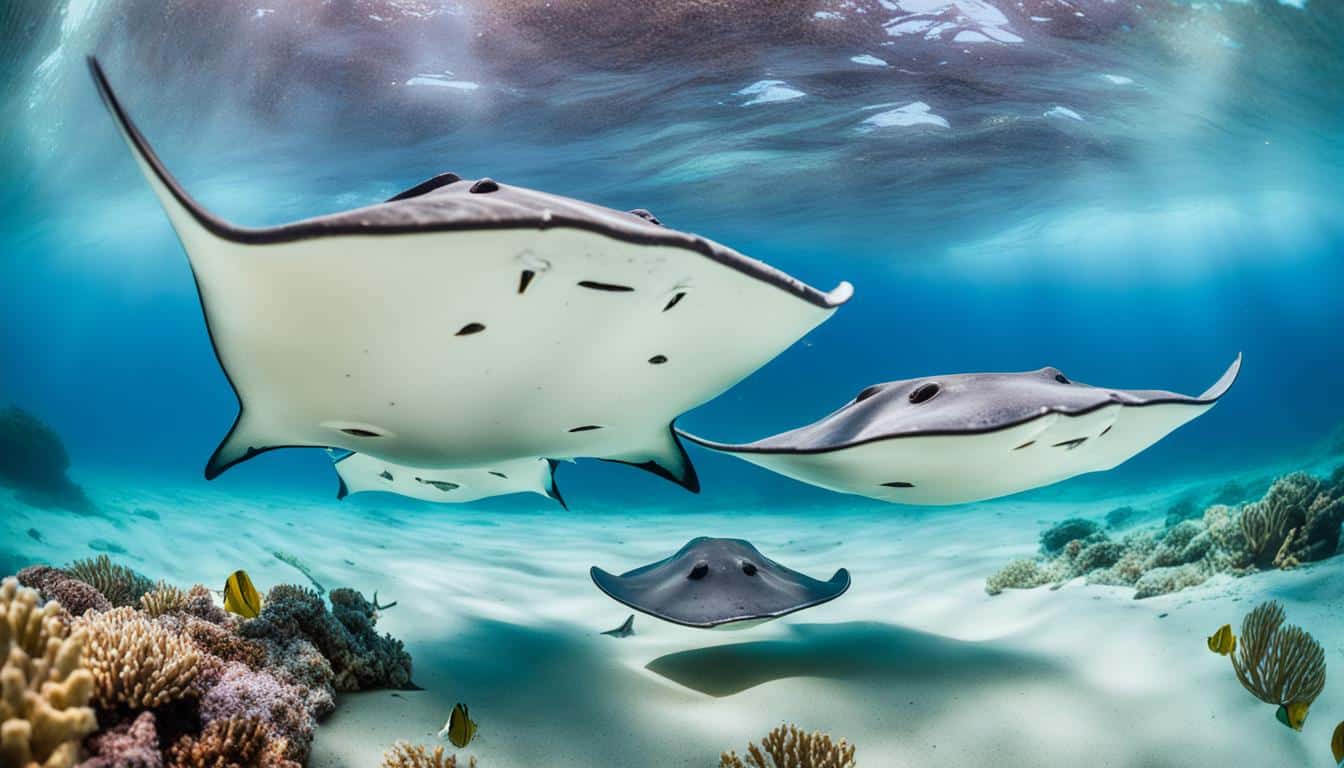Learning about what stingrays eat helps us understand these amazing sea creatures. These carnivorous animals mainly eat smaller sea creatures found on the ocean floor. Their diet includes worms, clams, oysters, snails, shrimp, and small fish.
Stingrays have special ways of finding food that help them survive. Their flat bodies let them blend into the sand to sneak up on prey. They have mouths on the bottom of their bodies, which they use to sweep the ocean floor for food. This shows how stingrays have adapted to their environment in unique ways.
Understanding the Carnivorous Diet of Stingrays
The diet of stingrays is key to their survival and health. Learning about their food habits shows how they’ve adapted to their environments. Their jaws, made of thick cartilage, help them crush hard-shelled prey like clams and crabs. This skill lets them access different types of food, making them important predators in the ocean.
Stingrays also have special senses that help them find food. They have the Ampullae of Lorenzini, which lets them feel electrical signals from prey. This is crucial for hunting in murky waters where they can’t see well. By understanding their feeding habits, we see how stingrays play a vital role in the ocean’s balance.
What do stingrays eat?
Stingrays play a key role in marine ecosystems. They have varied diets that depend on their species, size, and where they live. This lets them survive in different environments.
Common Prey of Stingrays
Stingrays mainly eat benthic organisms. Their diet includes:
- Worms
- Small benthic invertebrates
- Crustaceans (such as shrimp and crabs)
- Small fish
These foods are crucial for their survival in various ocean habitats.
Feeding Habits of Different Stingray Species
Stingrays have different eating habits. For example:
| Species | Typical Prey | Feeding Method |
|---|---|---|
| Southern Stingray | Crustaceans, mollusks | Excavating the substrate |
| Atlantic Manta Ray | Zoea larvae, plankton | Filter feeding |
| Blacktip Reef Ray | Small fish, sea urchins | Ambush or active hunting |
This table shows the variety in stingray diets and how they adapt to their surroundings.

Stingray Feeding Behavior and Techniques
Stingrays have fascinating ways of hunting that help them catch food. They often search for prey by skimming along the ocean floor. This method lets them use the environment to their advantage, especially in sandy and shallow areas.
Skimming the Ocean Floor
Stingrays move over the ocean floor with their flat bodies, making them hard to see. By doing this, they stir up the sand and find hidden creatures like mollusks and crustaceans. This way, they can find food and stay safe from predators.
Their hunting is a mix of speed and patience. They move over a big area to find food. This makes them skilled foragers.
Use of Ampullae of Lorenzini for Locating Prey
Stingrays also have special organs called Ampullae of Lorenzini. These help them sense the electric signals from other living things. In murky waters, this is very useful.
With their Ampullae of Lorenzini, stingrays can find hidden prey easily. This makes their hunting very precise and successful.
Stingray Nutrition: What Makes a Balanced Diet?
Understanding stingray nutrition is key to appreciating these amazing creatures. A balanced diet affects their growth, reproduction, and health. In the wild, stingrays eat a variety of food like crustaceans, mollusks, and small fish. This mix is important because it gives them the nutrients they need to stay healthy.
In aquariums, feeding stingrays right can be tricky. Certain vitamins and minerals are crucial for their health. For example, iodine, vitamin E, and thiamine help with thyroid function and overall health. While they can get some of these from their food, aquariums might need to add supplements to meet their needs.
Learning about stingray nutrition helps us keep them healthy in captivity and understand their natural eating habits. This knowledge is important for conservation and understanding their role in the ocean. To keep stingrays healthy, we must keep studying and adjusting their diets in both the wild and aquariums.
FAQ
What do stingrays primarily eat?
Stingrays eat smaller animals like worms, clams, oysters, snails, shrimp, and small fish. They eat what they can find in their home waters.
How do the feeding habits of stingrays vary among different species?
Stingrays of different sizes and habitats eat different things. Big rays eat bigger fish or squid. Smaller ones stick to softer, smaller food.
What adaptations do stingrays have for their feeding behavior?
Stingrays have special bodies that help them hunt. They can hide in the sand to find food. Their mouths are under their bodies, perfect for picking up food from the ocean floor.
How do stingrays locate their prey?
Stingrays use a special sense called the Ampullae of Lorenzini to find their food. This helps them in murky waters.
Why is a balanced diet important for stingrays?
A balanced diet keeps stingrays healthy and helps them grow and reproduce. It gives them the vitamins and minerals they need to thrive in the ocean.







